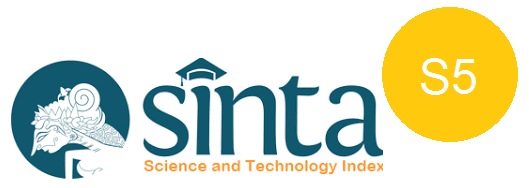SEMANTIC CHANGE AND MEANING SHIFT ANALYSIS ON NARRATIVE TEXTS’ DIALOGUES AMONG THE CHARACTERS IN THE SECOND YEAR ENGLISH TEXTBOOKS OF SENIOR HIGH SCHOOL
DOI:
https://doi.org/10.47313/pujangga.v3i1.327Abstract
ABSTRACT
The purposes of this study are to (1) describe the types of semantic change existing in characters’ dialogues of the narrative text in high school English textbooks class X; (2) distinguish the conceptual meaning and new meaning in characters’ dialogues of the narrative text; and (3) show the cause of meaning shift in characters’ dialogues of the narrative text. This research approach uses a qualitative approach with descriptive methods, because it deals with the qualitative data, the corpus of words. These research findings both in the textbooks The Spotlight containing seven narrative texts and Real Time containing six narrative texts. They indicate a change and a shift in meaning as a result of the contexts of the use of language.)
Key Words: semantic change, meaning shift, narrative texts’ dialogues, characters
ABSTRAK
Penelitian ini bertujuan (1) mendeskripsikan jenis perubahan semantik dialog antartokoh dalam teks naratif pada buku bahasa Inggris SMA kelas X; (2) membedakan makna konseptual dan makna baru dalam dialog antartokoh dalam teks naratif; dan (3) menunjukkan penyebab pergerseran makna dalam dialog antartokoh dalam teks naratif. Pendekatan penelitian ini menggunakan pendekatan kualitatif dengan metode deskriptif karena berkenaan dengan data kualitatif, yakni korpus kata. Hasil temuan penelitian ini baik pada buku teks The Spotlight yang memuat 7 teks naratif maupun buku teks Real Time yang memuat 6 teks naratif, keduanya menunjukkan adanya perubahan dan pergeseran makna sebagai akibat dari konteks penggunaan bahasa.
Kata Kunci: perubahan makna, pergeseran makna, teks naratif ‘dialog’, karakter
References
Baker, Peter 2007. Introduction to Old English. Oxford: Blackwell Publishing. Campbell, Lyle & Richard Janda 2001. “Introduction: Conceptions of Grammaticalization and their
Problems”. Language Sciences 23. Curzan, Anne 2003. Gender Shifts in the History of English. Cambridge: Cambridge University Press. Eckardt, Regine 2006. Meaning Change in Grammaticalization. Oxford: Oxford University Press. Derewianka, Beverly.1990. Exploring How Texts Work. Rozelle: Primary English Teaching Association. Hardy, Judy and Klarwein, Damien. 1990. Written Genres in the Secondary School. Brisbane,
Australia: Department of Education, Queensland. Grice, H.P. 1975. “Logic and Conversation”, in Peter Cole and Jerry L. Morgan (eds.), Syntax and
Semantics Vol. 3, Speech Acts. New York: Academic Press. Heine, Bernd and Tania Kuteva 2002. World Lexicon of Grammaticalization.
Cambridge: Cambridge University Press. Janda, Richard 2001. “Beyond 'pathways' and 'unidirectionality': on the Discontinuity of Language
Transmission and the Counterability of Grammaticalization”. Language Sciences 23. Joseph, Brian 2003. “Morphologization from Syntax”. In Joseph and Janda (eds.), The Handbook of
Historical Linguistics. Oxford: Blackwell Publishing. Lyons, Christopher 1999. Definiteness. Cambridge: Cambridge University Press. Traugott 2003. Grammaticalization. Cambridge: Cambridge University Press.
Jaisser, and Singmaster (eds.), “Berkeley Linguistics Society 14”
Traugott, Elizabeth and Bernd Heine 1991. Introduction to Traugott and Heine (eds.), Approaches to Grammaticalization Vol. I. Amsterdam: Benjamins.
Traugott, Elizabeth and Richard Dasher. 2005. Regularity in Semantic Change.
Cambridge: Cambridge University Press.









